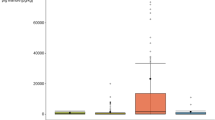Abstract
Background. Veterinary drugs are widely used in animal production and possibly reach soil and water through the excreta. There is only limited information concerning the environmental persistence of these substances. Tetracyclines represent the most frequently used antibiotics and accounted for more than 50% of the total amount of veterinary drugs employed through veterinary purchase orders in the Weser-Ems district in 1997.
Objectives. It was therefore the objective of the present study to investigate the excretion patterns of tetracycline hydrochloride in pigs after oral application and to study the stability of tetracycline in pig slurry under different storage conditions.
Methods 6 individually kept pigs were orally treated with two doses of tetracycline for 5 days and pooled excreta were regularly sampled. Stability testing was performed using 300 1 tanks which were spiked with 20 and 100 µg ml-1 tetracycline and stored at different ambient temperatures for seven weeks. 181 random pig slurry samples were obtained from commercial farms. Tetracycline and its epimer 4-epi-tetracycline were detected using HPLC.
Results Orally applied tetracyclines were rapidly excreted via feces and urine, and significant amounts (up to 72%) of the active ingredient which had initially been dispensed were recovered until the second day after the end of application. Individual animals continued to excrete tetracyclines over a longer period of time. Tetracycline hydrochloride demonstrated a distinct stability in slurry which was not significantly influenced by the initial concentration of the antibiotic, ambient temperature or aeration through repeated stirring. Half-lives ranged between 55 and 105 days.
Conclusion Significant amounts of tetracycline are transferred to soil via manure application. There is considerable need for further research into environmental effects such as sorption and mobility, and microbiological changes. This is also the case for other substances which have not undergone valid environmental risk assessment.
Similar content being viewed by others
References
Commission of the EEC (1992): Directive 92/18/EEC. Commission Directive modifying the Annex to Council Directive 81/ 852/EEC on the approximation of the laws of Member States relating to the analytical, pharmacotoxicological and clinical standards and protocols in respect of the testing of veterinary medicinal products. Off J EECL 97, 1–12
Danish Institute of Agricultural Sciences (DIAS) (1997): Antibiotika- forbruget i danske husdyrbesætninger. DIAS. Foulum: 38–51
European Agency for the Evaluation of Medicinal Products (EMEA) (2000): Guideline on environmental impact assessment for veterinary medicinal products CVMP/VICH/592/98. London, United Kingdom
Frey HH, LöscherW (1996): Lehrbuch der Pharmakologie und Toxikologie für die Veterinärmedizin. F. Enke-Verlag, Stuttgart
Gavalchin J, Katz SE (1994): The persistence of fecal-borne antibiotics in soil. J. AOAC Int77: 481–485
Grafe A (2001): Untersuchungen zum Einsatz pharmakologisch wirksamer Stoffe in der Veredelungswirtschaft unter besonderer Berücksichtigung der Tetrazykline. Doctoral thesis, University of Goettingen, in press
Hamscher G, Sczesny S, Abu-Quare A, HöperH (2000): Stoffe mit pharmakologischer Wirkung einschließlich hormonell aktiver Substanzen in der Umwelt: Nachweis von Tetrazyklinen in güllegedüngten Böden. Dtsch tierärztl Wschr107: 332–334
Herd RP, Sams RA, Ahscraft SM (1996): Persistence of ivermectin in plasma and faeces following treatment of cows with ivermectin sustained-release, pour-on or injectable formulations. Int J Parasitol26: 1087–1093
Hilpert R, Winter J, KandlerO (1984): Agricultural feed additives and disinfectants as inhibitory factors in anaerobic digestions. Agricultural Wastes10, 103–116
Hirsch R, Ternes TA, Haberer K, Mehlich A, Ballwanz F, Kratz KL (1998): Determination of antibiotics in different water compartments via liquid chromatography-electrospray tandem mass spectrometry. J ChromatogrA 815, 213–223
Hlavka JJ, Boothe JH (1985): The Tetracyclines. Springer Verlag, Berlin, Heidelberg, New York, Tokyo
JagnowG (1977): Mikrobieller Abbau der Futtermittelantibiotika Zink-Bacitracin, Flavophospholipol, Spyramycin und von Tetracyclin in feucht gelagertem und in mit Boden vermischtem Hühnerkot. Proc Landwirtsch Forsch, Part 1: 227–234
KrokerR (1983): Aspekte zur Ausscheidung antimikrobiell wirksamer Substanzen nach der chemotherapeutischen Behandlung von Nutztieren. Wissenschaft und Umwelt4: 305–308
Kühne M, Wegmann S, Kobe A, FriesR (2000a): Tetracycline residues in bones of slaughtered animals. Food Control11, 175–180
Kühne M, Ihnen D, Möller G, AghteO (2000b): Stability of tetracycline in water and liquid manure. J Vet Med A47: 379–384
Langhammer J-P (1989): Untersuchungen zum Verbleib antimikrobiell wirksamer Arzneistoffe als Rückstände in Gülle und im landwirtschaftlichen Umfeld. Doctoral thesis, University of Bonn.
Langhammer J-P, Büning-Pfaue H, Winkelmann J, KörnerE (1988): Chemotherapeutika-Rückstände und -Resistenzverhalten bei der Bestandsbehandlung von Sauen post partum. Tierärztl Umschau43, 375–382
Lunestad BT, GoksoyrJ (1990): Reduction in the antibacterial effect of oxytetracycline in sea water by complex formation with magnesium and calcium. Dis Aquat Org.9: 67–72
Oka H, Ikai Y, Kawamura N, Yamada M, Harada K, Ho S, SuzukiM (1989): Photodecomposition products of tetracycline in aqueous solution. J Agric Food Chem37, 226–231
Rabølle M, Spliid NH (2000): Sorption and mobility of metronidazol, olaquindox, oxytetracycline and tylosin in soil. Chemosphere40: 715–722
Ramazza V, Zucchi M, Lanzoni A, BianchiC (1996): Presence of oxytetracycline in pig farming after higher doses and longer administration times in comparison to the suggested ones. Proc. Euro Residue Conference III, Veldhoven, The Netherlands, Vol2: 814–818
Rassow D, SchaperH (1996): Zum Einsatz von Fütterungsarzneimitteln in Schweine- und Geflügelbeständen in der Region Weser- Ems. Dtsch tierärztl Wschr103: 237–284
Samuelsen OB, Lunestad BT, Ervik A, FjeldeS (1994): Stability of antibacterial agents in an artificial marine aquaculture sediment studied under laboratory conditions. Aquaculture126: 283–290
Sithole BB, Guy RD (1987): Models for oxytetracycline in aquatic environments. Interactions with humic substances. Water, Air, and Soil Pollution32, 315–321
StrongL (1993): Overview: the impact of avermectins on pastureland ecology. Vet Parasitol48: 3–17
Winckler C, GrafeA (2000): Abschätzung des Stoffeintrags in Böden durch Tierarzneimittel und pharmakologisch wirksame Futter- zusatzstoffe. UBA-Texte 44/00, Berlin
Author information
Authors and Affiliations
Corresponding author
Rights and permissions
About this article
Cite this article
Winckler, C., Grafe, A. Use of veterinary drugs in intensive animal production. J Soils Sediments 1, 66–70 (2001). https://doi.org/10.1007/BF02987711
Received:
Accepted:
Issue Date:
DOI: https://doi.org/10.1007/BF02987711




